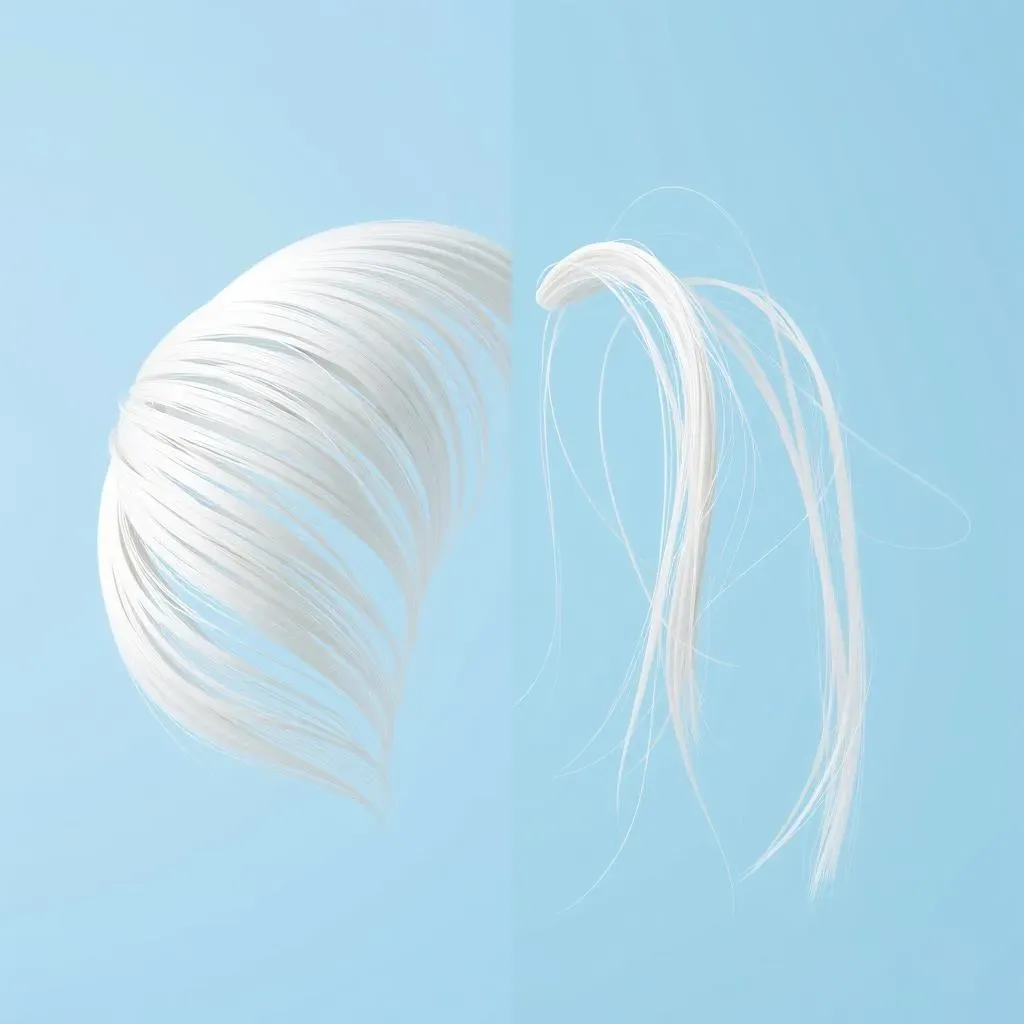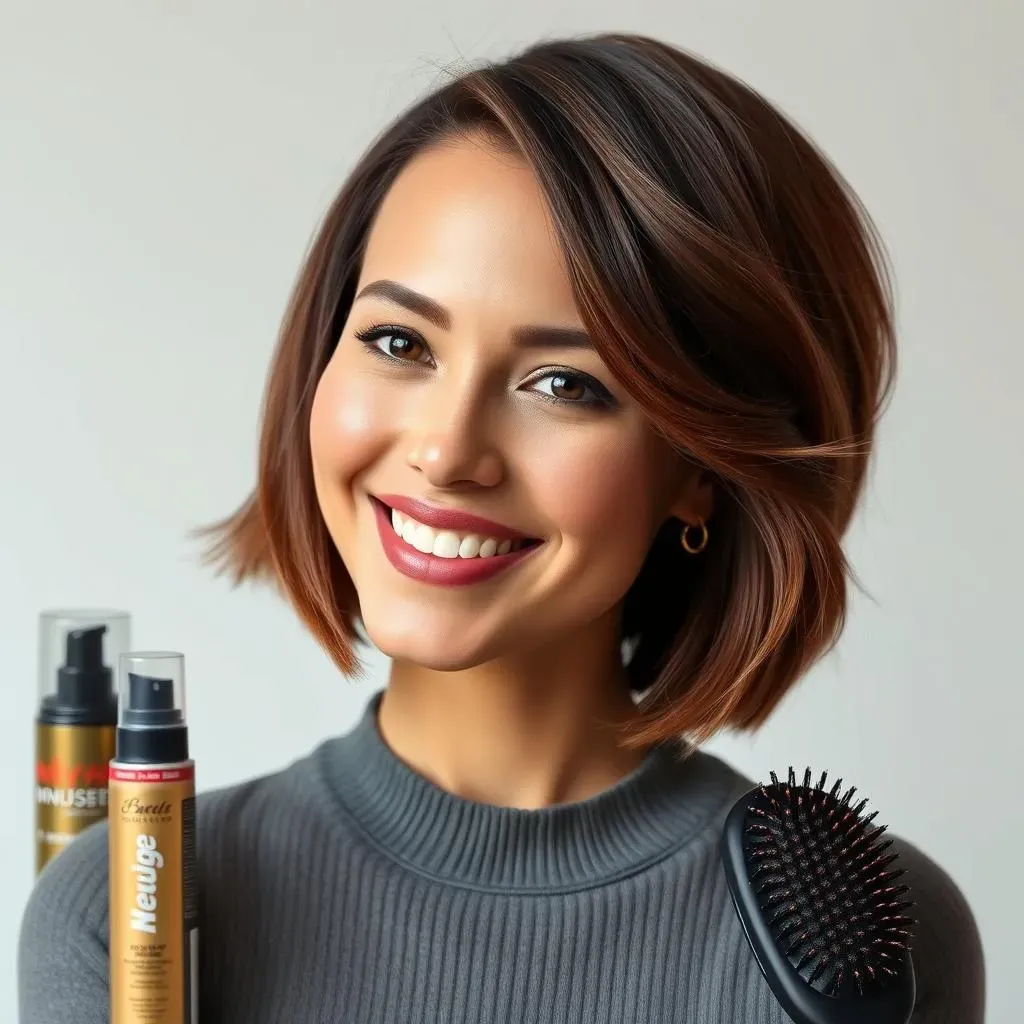Is your fine, thin hair making you feel like you’re stuck in a style rut? You're not alone. Many of us with delicate strands struggle to find a cut that doesn't fall flat. But guess what? The right bob can be a total game-changer. We're not talking about those boring, limp styles of the past. This guide is all about finding the best bob cut for fine thin hair, one that adds volume, texture, and a whole lot of personality. Forget the idea that short hair is a no-go for fine hair. We’ll walk you through the key differences between fine and thin hair, explore various bob styles that actually work, and give you the styling secrets to make the most of your new look. Get ready to say goodbye to flat, lifeless locks and hello to a chic, confidence-boosting bob. This isn't just about a haircut; it's about discovering the best version of your hair.
Understanding Fine vs. Thin Hair

Understanding Fine vs. Thin Hair
The Confusion Unveiled
let's get one thing straight: fine hair and thin hair are not the same thing, even though they often get mixed up. Think of it this way – fine hair refers to the actual diameter of each individual strand. It’s like comparing the thickness of a thread to a piece of yarn. Fine hair is super delicate, almost like silk. It doesn’t mean you have less hair, just that each strand is, well, finer. This is something I had to learn the hard way, always wondering why my hair looked so different from my friends.
On the other hand, thin hair is about density. It’s about how many strands you have on your head. Someone can have fine hair but a lot of it, making their hair appear full, or they can have coarse hair but not very much of it, making their hair appear thin. It’s all about the amount of hair you’ve got. So, you can have fine hair that’s thick, thin hair that’s coarse, or any combo in between. It's like trying to figure out if you have a crowded room of tiny people or a sparse room of big people.
Why It Matters for Your Bob
Now, why is this distinction so crucial when we're talking about the best bob cut for fine thin hair? Because the way your hair behaves depends on these factors. Fine hair tends to be limp and can lack volume, while thin hair may struggle with overall fullness and coverage. A bob cut for fine hair needs to create the illusion of thickness, while a bob for thin hair needs to add the appearance of more hair. If you have both fine and thin hair, you need a cut that addresses both of these challenges. It’s like needing a special recipe that caters to both a delicate flavor and a hearty portion.
Understanding this difference is the first step in making sure you pick a bob that is going to work for you. It's like trying to build a house; you need to know the lay of the land before you start laying bricks. It's not about fighting your hair, but working with its unique characteristics to find a style that will make you feel fantastic.
Quick Guide: Fine vs. Thin
To make it super clear, here's a quick table to help you remember the key differences:
Characteristic | Fine Hair | Thin Hair |
|---|---|---|
Strand Thickness | Small diameter, delicate | Can be any thickness, but low density |
Volume | Often lacks volume, can be limp | Lacks fullness, may show scalp |
Density | Can have high or low density | Low density, fewer strands |
Remember, it's not about having 'bad' hair, it's about understanding what you're working with. Once you know the difference between fine and thin, you're one step closer to finding the best bob cut for fine thin hair.
Bob Styles That Work Wonders for Fine Thin Hair

Bob Styles That Work Wonders for Fine Thin Hair
The Blunt Bob: A Solid Foundation
let's talk about the blunt bob. This is like the superhero of haircuts for fine, thin hair. Why? Because it creates a solid weight line at the bottom, making your hair appear thicker and fuller. It's all about that clean, straight edge. No wispy ends here! When I first tried a blunt bob, I couldn’t believe the difference. It was like my hair suddenly had a backbone. It’s a simple, yet powerful way to add some oomph to your look, and it's super easy to style, which is a huge win in my book.
The beauty of the blunt bob is its versatility. You can wear it sleek and straight for a polished look, or add some texture with a little bit of product for a more relaxed vibe. It’s also a great base for other styling techniques like waves or curls, which can further enhance the appearance of thickness. If you're feeling a bit daring, you can even add a micro bang for extra volume and personality, but we'll get to bangs later.
The Textured Bob: Adding Dimension
Now, if a blunt bob feels a little too straightforward, let's explore the textured bob. This style is all about adding movement and dimension to your hair. Instead of a harsh, straight line, the ends are slightly layered, creating a more dynamic look. Think of it as adding some spice to your hairstyle – a little bit of "oomph" here and there. It helps avoid that flat, lifeless look that fine, thin hair can sometimes have. This was my go-to when I wanted a style that wasn't too fussy but still looked like I put some effort in.
The key to a great textured bob is to avoid over-layering. You want soft, subtle layers that add movement without making your hair look thinner. The right amount of texture can make your hair appear fuller and more voluminous. You can achieve this with a good texturizing spray or by using a curling iron to create loose waves. It’s all about creating the illusion of depth and volume, and it works like a charm, especially if you have fine hair that tends to lie flat.
Here's a quick comparison to help you choose:
Bob Style | Key Feature | Best For |
|---|---|---|
Blunt Bob | Solid, straight edge | Adding weight and fullness |
Textured Bob | Soft, subtle layers | Adding movement and dimension |
The Angled Bob: A Touch of Drama
If you're looking for something that adds a bit more drama, the angled bob might be your match. This style is shorter in the back and gradually gets longer towards the front, creating a sleek and modern look. The angled cut can add a sense of volume and movement, especially when styled with some texture. It's a great option if you want a bob that stands out and says, "I'm here and I'm fabulous." I remember trying this out and feeling like I had a whole new attitude!
The angle can be subtle or quite dramatic, depending on your preference. A more subtle angle is great for adding a bit of lift at the roots, while a more dramatic angle can create a striking silhouette. The key is to find an angle that works well with your face shape and hair texture. Like the blunt bob, the angled bob also benefits from a good texturizing product to add volume and hold. The extra length in the front can frame your face nicely and add a bit of sophistication. It's a versatile style that can be dressed up or down, making it perfect for any occasion.
Styling Tips to Maximize Your Bob's Potential

Styling Tips to Maximize Your Bob's Potential
The Right Products Are Key
so you’ve got your best bob cut for fine thin hair, now what? It's time to talk about styling products, the unsung heroes of a great hair day. For fine, thin hair, you need products that add volume and texture without weighing your hair down. Think lightweight mousses, texturizing sprays, and volumizing powders. Avoid heavy creams or oils that can make your hair look greasy and flat. I made the mistake of using a heavy serum once, and it was like my hair had given up on life. So, go for products that are your hair's best friend, not its worst enemy. Start with a small amount of product and build up as needed, it’s always easier to add more than take away.
A good volumizing mousse applied at the roots before blow-drying can create lift and fullness. Texturizing sprays are great for adding some grit and definition to the ends, giving that "lived-in" look. And don't underestimate the power of a little dry shampoo, even on clean hair! It can add instant volume and absorb any excess oil. Remember, the goal is to create the illusion of thicker, fuller hair, so you need products that can help you achieve that. It's about working smarter, not harder, with your styling routine.
Mastering the Blow-Dry
The way you blow-dry your hair can make or break your bob. For fine, thin hair, you want to focus on creating lift at the roots. Start by flipping your head upside down and drying your hair in this position. This will help to lift the roots off the scalp, adding volume. Use a round brush to lift the hair at the roots as you dry, pulling it upwards and outwards. Avoid directing the heat directly onto the ends of your hair, as this can make them appear frizzy and damaged. I’ve found that using a diffuser attachment can be a great way to add volume without creating frizz, especially if you have wavy or curly hair.
Once your hair is mostly dry, flip your head back up and style as desired. Use a cool shot of air to set the style and add shine. Remember, the goal is to create volume and movement, not to make your hair perfectly sleek and straight. A little bit of texture and imperfection is your friend. It’s like trying to paint a masterpiece; you need the right tools and techniques to create something beautiful, and the same goes for your hair. It's not about achieving a perfect look but about creating a style that feels confident and effortless.
Styling Step | Technique | Why It Works |
|---|---|---|
Product Application | Lightweight mousse, texturizing spray | Adds volume without weighing hair down |
Blow-Drying | Flip head upside down, use round brush | Lifts roots for added volume |
Finishing Touches | Cool shot, dry shampoo | Sets style, adds texture and absorbs oil |
Adding Texture and Waves
If you want to take your bob to the next level, try adding some texture and waves. This can be achieved with a curling iron, a flat iron, or even by braiding your hair while it's damp. The key is to create loose, natural-looking waves, not tight, structured curls. I love using a flat iron to create soft bends in my hair, it’s quick and easy, and it adds just the right amount of texture. For a more relaxed look, try using a salt spray to give your hair that beachy, tousled vibe. It’s like giving your hair a day at the beach, without actually going to the beach.
When using a curling iron or flat iron, avoid starting too close to the roots. Focus on the mid-lengths and ends of your hair. This will prevent your hair from looking too puffy at the top. And always remember to use a heat protectant spray before styling to avoid any damage. Experiment with different techniques to see what works best for your hair texture and length. It’s like trying out new dance moves; you might stumble a bit at first, but with practice, you’ll find your rhythm. It's all about having fun and expressing yourself through your hairstyle.
The Power of the Part
Don't underestimate the power of a good part. The way you part your hair can have a huge impact on how your bob looks. A deep side part can add volume at the roots and create a more dramatic look, while a center part can give a more balanced and symmetrical appearance. If you’re struggling with flatness at the roots, try switching up your part to the opposite side. This will instantly add volume and lift. I’ve been known to change my part multiple times a day, just to keep things interesting. It’s like moving the furniture around in a room; a small change can make a big difference.
Experiment with different part styles to see what works best for your face shape and hair texture. A zig-zag part can add a bit of playfulness, while a slightly off-center part can add a touch of sophistication. The key is to find a part that complements your features and makes you feel confident. It’s not about following trends, it’s about finding what works best for you. It's like finding the perfect frame for a picture; it enhances the beauty of what's inside.
- Use lightweight volumizing products.
- Blow-dry upside down for root lift.
- Add texture with waves or bends.
- Experiment with different parts.
Finding Your Perfect Bob: It's All About the Fit
So, there you have it – a rundown on the best bob cut for fine thin hair. It's not about chasing trends, but about finding a style that truly works with your hair's unique texture and your personal vibe. Whether you're leaning towards a sleek, blunt bob or a textured, wavy style, remember that the key is in the details. From understanding the difference between fine and thin, to choosing the right length and styling products, each step contributes to a bob that looks fabulous and boosts your confidence. Don't be afraid to experiment, chat with your stylist, and most importantly, have fun with your hair. A great bob isn't just a haircut, it's a statement – make sure yours is saying exactly what you want it to.